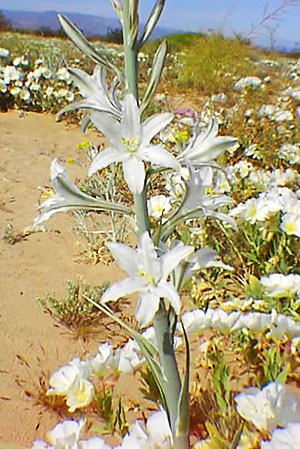Hesperocallis
Hesperocallis is a genus of flowering plants that belongs to the family Asparagaceae. It is a monotypic genus, meaning it contains only one species, Hesperocallis undulata, commonly known as the desert lily or Ajo lily. This plant is native to the desert regions of the southwestern United States and northwestern Mexico, particularly found in the Sonoran Desert and surrounding areas.
Description[edit | edit source]
Hesperocallis undulata is a perennial, bulbous plant that produces long, wavy, bluish-green leaves. The leaves emerge from the ground in a rosette formation, and the plant can reach up to 50 cm in height. In spring, typically after sufficient rainfall, it blooms with large, fragrant, white flowers that have a striking resemblance to lilies, hence the name desert lily. Each flower is borne on a tall stalk that rises above the foliage, showcasing the beauty of the plant in its harsh desert habitat.
Habitat and Distribution[edit | edit source]
The desert lily is adapted to survive in arid environments with minimal water. It is found in sandy soils, often in valleys and on gentle slopes, where it can take advantage of the limited moisture available. Its distribution spans from the southwestern United States, including parts of California, Arizona, and Nevada, extending into the northwestern region of Mexico. The plant's ability to thrive in desert conditions is a testament to its resilience and adaptability.
Ecology[edit | edit source]
In its natural habitat, Hesperocallis undulata plays a role in the desert ecosystem. It serves as a source of nectar for various pollinators, including bees and moths. The plant's flowering cycle is closely tied to the rainfall patterns of its environment, with blooms appearing most abundantly after wet winters. This synchronization ensures that pollinators are available when the flowers are ready for pollination, facilitating the reproduction of the species.
Conservation[edit | edit source]
While not currently listed as endangered, the desert lily faces threats from habitat destruction and overcollection. Urbanization, mining, and agricultural expansion are factors that contribute to the loss of its natural habitat. Conservation efforts are necessary to ensure the survival of this unique species in its native range. Protecting the areas where it grows and regulating collection can help preserve the desert lily for future generations to appreciate.
Cultural Significance[edit | edit source]
The desert lily has long been admired for its beauty and resilience, making it a symbol of the desert's hidden treasures. It has cultural significance to the indigenous peoples of the region, who have used the plant for various purposes, including as a food source. The bulb of the desert lily is edible and was traditionally harvested for its nutritional value.
See Also[edit | edit source]
Navigation: Wellness - Encyclopedia - Health topics - Disease Index - Drugs - World Directory - Gray's Anatomy - Keto diet - Recipes
Search WikiMD
Ad.Tired of being Overweight? Try W8MD's physician weight loss program.
Semaglutide (Ozempic / Wegovy and Tirzepatide (Mounjaro / Zepbound) available.
Advertise on WikiMD
WikiMD is not a substitute for professional medical advice. See full disclaimer.
Credits:Most images are courtesy of Wikimedia commons, and templates Wikipedia, licensed under CC BY SA or similar.Contributors: Prab R. Tumpati, MD

